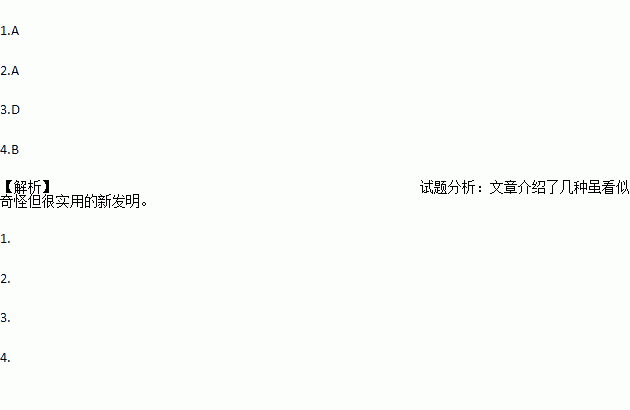题目内容
There are a lot of products out there that make your life easier. Some, however, are a little sillier than others — so much that they seem like joke products. Here are a few products that sound crazy, but actually rule.
Sleep Phones
It’s hard to imagine something sillier than a music-playing headband you wear while you sleep, but they exist — and are quite popular. Sleep Phones won’t give you the highest quality sound in the world, but if you prefer to fall asleep to music, they’re far more comfortable than normal headphones. While they’re a bit expensive, they might be perfect for you. There’s also a wireless version (版本) if you prefer.
Onion Goggles
If cutting onion____________no matter what you try, it’s time for desperate measures. We tested a bunch of methods for avoiding onion tears, and found the best solutions came down to cutting the onion under a vent (通风孔), or wearing these stylish and awesome goggles.
Lock Laces
There’re some great ways to tie your shoes better, but if you long for the laceless shoes of your childhood days, Lock Laces are a pretty good choice. They’re basically elastic (有弹性的) laces that remove the need to tie your shoes. Sure, people will make fun of you, but you can make fun of them after they trip over their own untied laces. Or you can make your own slip-on shoes with elastic tubing.
2D-Glasses
Hate 3D-movies, but have to go to one? The difference between 2D-glasses and 3D-glasses lies in their lenses (镜片). Each lens of 2D-glasses blocks the same picture, so each eye gets the same picture, while each lens of 3D-glasses blocks a different picture, so each eye gets a different picture which the brain interprets as 3D. Now you have a pair of glasses that can save you from the headache caused by wearing 3D-glasses which are popular in our movie theaters. You can buy them or make a pair for yourself.
1.What do we know about Sleep Phones?
A. There are two versions.
B. They’re comfortable but unhealthy.
C. They give you the best quality sound.
D. They’re cheaper than other headphones.
2.The underlined part “brings on the waterworks” in the text probably means _____.
A. makes your eyes water
B. makes your fingers hurt
C. destroys your water pipes
D. adds to your washing work
3.What is the advantage of Lock Laces?
A. They are strong and lasting.
B. They help you walk comfortably.
C. They are stylish and eco-friendly.
D. They save you from tying your shoes.
4.Compared with 3D-glasses, 2D-glasses _____.
A. are cheaper and thinner
B. won’t give you a headache
C. let you see a different picture
D. are more popular in movie theaters
 黎明文化寒假作业系列答案
黎明文化寒假作业系列答案
